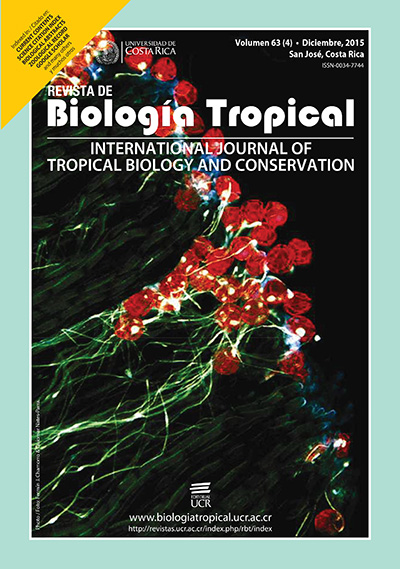Resumen
La mayoría de las especies del género neotropical Holopothrips se asocian a las agallas de plantas pero se sabe muy poco de su biología. Aquí, se provee observaciones sobre la biología de una nueva especie de Holopothrips que se asocia a las agallas de venas foliares en cuatro especies de Piper en un bosque nuboso (Zurquí de Moravia) de Costa Rica. Esta especie coloniza las agallas luego de que el cecidómido inductor o un parasitoide del mismo emerge, y aparentemente varias generaciones de trips ocupan las agallas vacías. Un total de 175 agallas vacías en 34 hojas fueron recolectadas, llevadas al laboratorio para disección bajo el microscopio y se cuantificó su contenido. Holopothrips ocupaba aproximadamente el 75 % de las hojas con agallas y en ellas el 40 % de las agallas. Se encontró toda combinación de adultos, ninfas y huevos, lo cual implica que los trips adultos entran y salen y posiblemente no defienden sus agallas de la invasión de otros miembros de su especie. Sin embargo, adultos y ninfas, levantan la punta del abdomen al ser perturbados, emitiendo un olor distintivo que sugiere una reacción defensiva ante posibles depredadores. La evidencia preliminar indica que se alimentan del tejido interior de la agalla y pasan muy poco tiempo fuera de la misma. Se describe la especie nueva y es una de sólo cuatro especies conocidas de Holopothrips que poseen dos pares de setas epimorales en el pronoto. Al compararla con estas otras especies surge una marcada variación en la espermateca de la hembra y en las placas del poro esternal en el macho, los cuales se ilustran. Se requiere más investigación para confirmar la sugerencia que varias generaciones de trips ocupan las agallas vacias, para determinar si es cierto que los trips adultos se mueven entre agallas, y para explorar en más detalle la supuesta defensa química.
Citas
Bournier, A. (1993). Thysanoptères de Martinique et de Guadeloupe. International Journal of Pure and Applied Zoology, 3, 227-240.
Cabrera, I., & Segarra, A. (2008). A new gall-inducing species of Holopothrips (Thysanoptera: Phlaeothripinae) from Tabebuia trumpet trees in the Caribbean Region. Florida Entomologist, 91, 232-236.
Cavalleri, A., & Kaminski, L. A. (2007). A new Holopothrips species (Thysanoptera: Phlaeothripidae) damaging Mollinedia (Monimiaceae) leaves in southern Brazil. Zootaxa, 1625, 61-68.
Costa, A. (1935) Tisanopterocecidias do Brasil. O Campo, 6, 25-29.
Gastreich, K. R., & Gentry, G. L. (2004). Faunal studies in model Piper spp. systems, with a focus on spider-induced indirect interactions and novel insect-Piper mutualisms. In L. A. Dyer, & A. P. N. Palmer (Eds.), Piper: a model genus for studies of phytochemistry, ecology, and evolution (pp. 97-116). New York: Kluwer Academic/Pelnum Publishers.
Mound, L. A., & Marullo, R. (1996). The Thrips of Central and South America: An Introduction. Memoirs on Entomology, International, 6, 1-488.
Risch, S. J., & Rickson, F. R. (1981). Mutualism in which ants must be present before plants produce food bodies. Nature, 291, 149-150.
ThripsWiki contributors. (2014, October 2). ThripsWiki - providing information on the World's thrips [Web Site]. Retrieved from http://thrips.info/wiki/Main_Page
##plugins.facebook.comentarios##

Esta obra está bajo una licencia internacional Creative Commons Atribución 4.0.
Derechos de autor 2015 Revista de Biología Tropical






